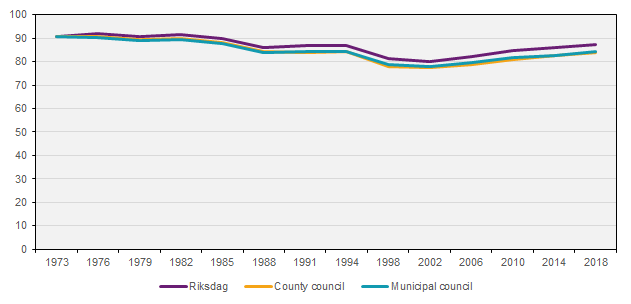General elections, results 2018
Highest turnout since 1985 general elections
Statistical news from Statistics Sweden 2018-11-21 9.30
Turnout increased for the fourth consecutive election in the 2018 general elections. More people than before also chose to vote in advance.
General elections were held on 9 September in Sweden, and Statistics Sweden is now publishing data on the 2018 general election results. In total, 8 031 793 persons were eligible to vote in at least one of the three elections. There were 7 495 936 eligible voters in the Riksdag election, 7 814 197 eligible voters in the county council election, and 7 861 590 eligible voters in the municipal council election. Statistics Sweden’s statistical database contains time series that allow a comparison of results from the different elections.
Voter turnout increased for the fourth consecutive election. In the Riksdag election, 6 535 271 persons voted, representing 87.2 percent in voter turnout, the highest turnout since the 1985 general elections. Turnout in the county council and municipal council elections was 83.7 percent and 84.1 percent respectively, which is the highest voter turnout in both elections since 1994.

The highest voter turnout in the 2018 Riksdag, county council and municipal council elections was registered in Lomma. The lowest voter turnout in the Riksdag, county council and municipal council elections was registered in Haparanda.
| Municipality | Highest voter turnout (%) | Municipality | Lowest voter turnout (%) |
|---|---|---|---|
| Lomma | 93.9 | Haparanda | 72.8 |
| Habo | 93.4 | Södertälje | 77.5 |
| Vellinge | 93.1 | Botkyrka | 78.2 |
| Vaxholm | 92.7 | Burlöv | 80.8 |
| Ekerö | 92.2 | Sorsele | 80.8 |
| Municipality | Highest voter turnout (%) | Municipality | Lowest voter turnout (%) |
|---|---|---|---|
| Lomma | 92.5 | Haparanda | 63.3 |
| Vellinge | 92.0 | Södertälje | 69.4 |
| Habo | 90.5 | Eda | 69.7 |
| Öckerö | 90.0 | Botkyrka | 71.2 |
| Danderyd | 90.0 | Årjäng | 74.8 |
| Municipality | Highest voter turnout (%) | Municipality | Lowest voter turnout (%) |
|---|---|---|---|
| Lomma | 92.9 | Haparanda | 63.3 |
| Vellinge | 92.3 | Södertälje | 69.9 |
| Habo | 91.0 | Eda | 70.5 |
| Öckerö | 90.9 | Botkyrka | 71.4 |
| Vaxholm | 90.7 | Övertorneå | 76.2 |
Definitions and explanations
Eligible voters
Swedish citizens who are 18 years and older on election day and are registered in Sweden are eligible to vote in all elections. Swedish citizens registered abroad are eligible to vote in the Riksdag election. Foreign citizens are eligible to vote in municipal council and county council elections, if they are registered in Sweden and are citizens of an EU Member State, Norway, or Iceland. Citizens of other countries are also eligible to vote in municipal council and county council elections, if they have been registered in Sweden for three years prior to the elections. Gotland municipality does not have a county council, which explains the difference between the number of eligible voters in the municipal council and county council elections.
Threshold rule for small parties
The threshold rule in the Riksdag election is four percent, which means parties that win less than four percent of the votes are not assigned seats in the Riksdag. However, any party receiving at least 12 percent of the votes in any one constituency can participate in the allocation of seats, even if the party does not attain the four percent threshold at national level.
In county council elections, the threshold for small parties is three percent. In municipalities with more than one constituency, the threshold for small parties is three percent, while in municipalities with only one constituency, the threshold for small parties is two percent.
Statistical Database
More information is available in the Statistical Database
Feel free to use the facts from this statistical news but remember to state Source: Statistics Sweden.
